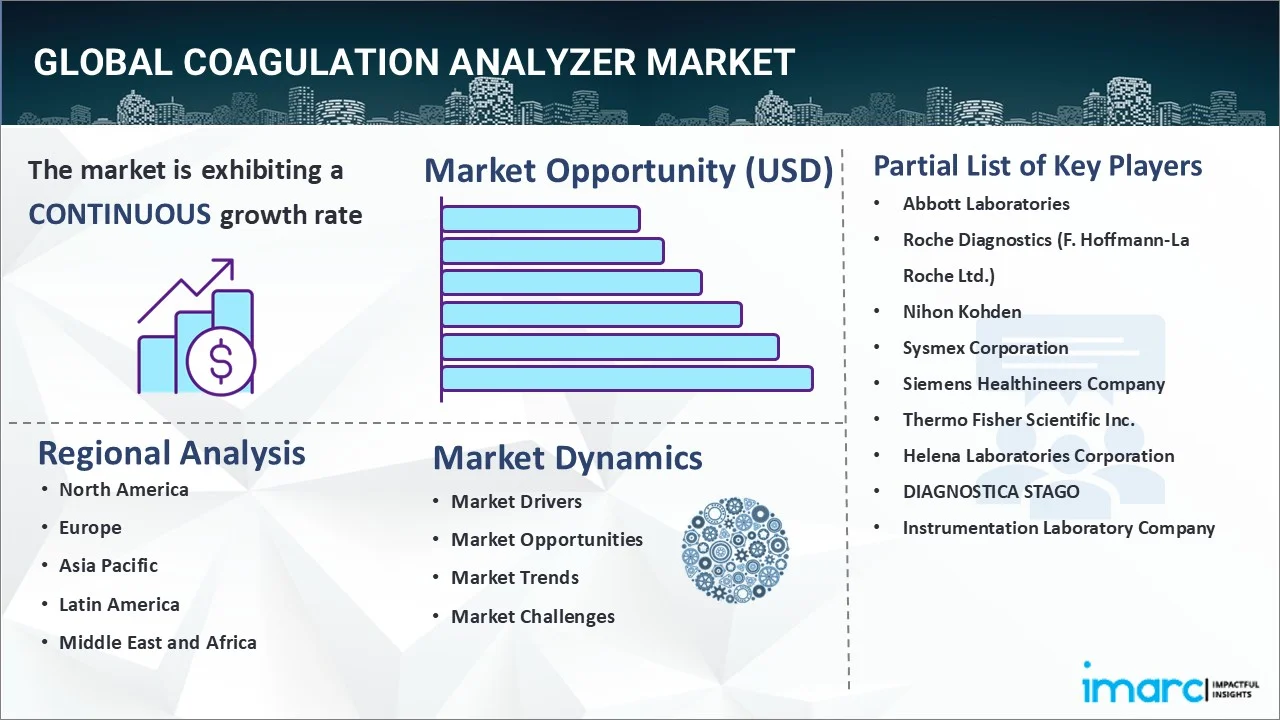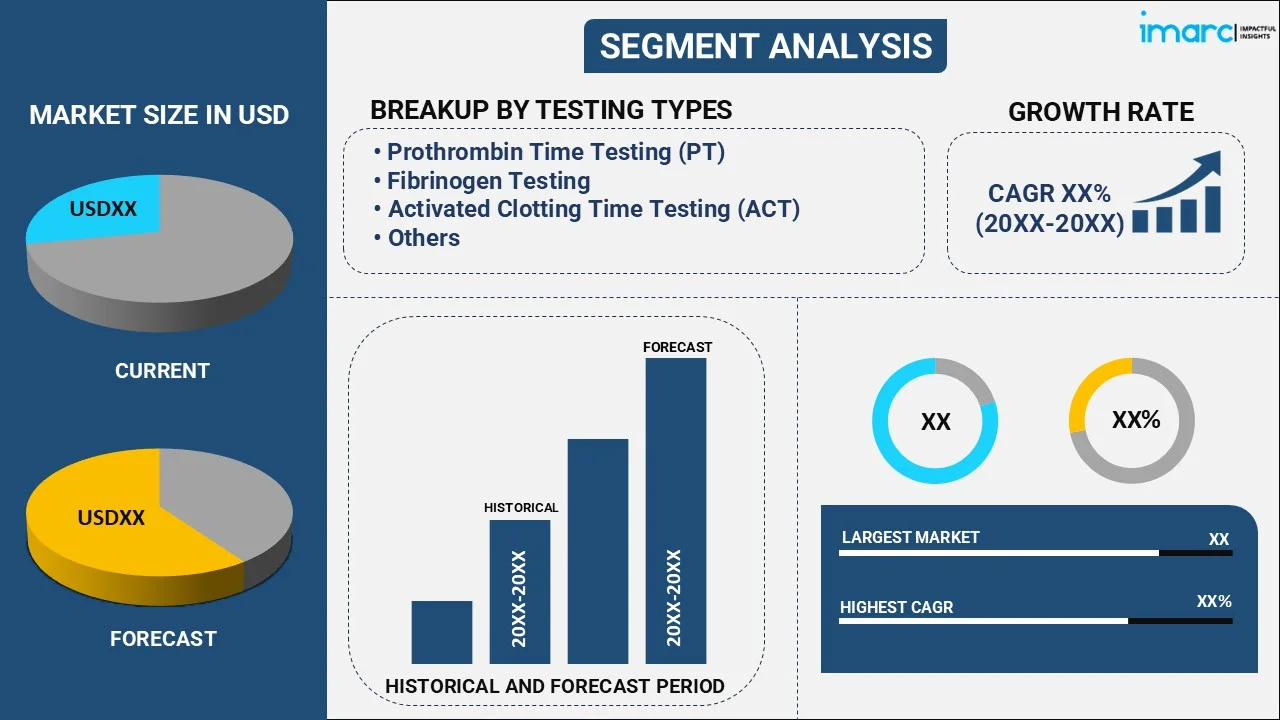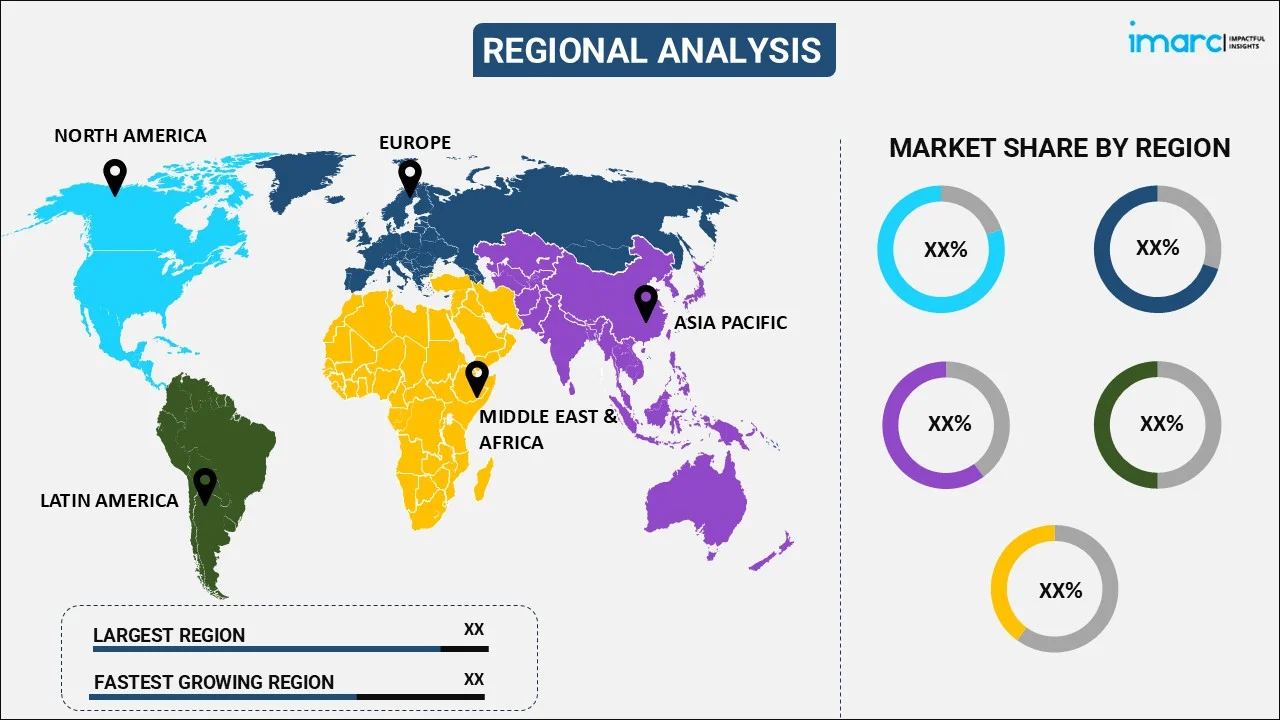
Coagulation Analyzer Market Report by Testing Type (Prothrombin Time Testing (PT), Fibrinogen Testing, Activated Partial Thromboplastin Time Testing (APTT), Activated Clotting Time Testing (ACT), D-Dimer Testing, Platelet Function Testing, Anti-Factor Xa Testing, and Others), Product Type (Instruments/Analyzers, Reagents, Consumables, and Others), Technology Type (Optical Technology, Mechanical Technology, Electrochemical Technology, and Others), End User (Clinical Laboratories, Diagnostic Centers, Hospitals, and Others), and Region 2025-2033
Market Overview:
The global coagulation analyzer market size reached USD 6.2 Billion in 2024. Looking forward, IMARC Group expects the market to reach USD 11.4 Billion by 2033, exhibiting a growth rate (CAGR) of 6.63% during 2025-2033.
|
Report Attribute
|
Key Statistics
|
|---|---|
|
Base Year
|
2024
|
|
Forecast Years
|
2025-2033
|
|
Historical Years
|
2019-2024
|
|
Market Size in 2024
|
USD 6.2 Billion |
|
Market Forecast in 2033
|
USD 11.4 Billion |
| Market Growth Rate 2025-2033 | 6.63% |
Coagulation, also known as hematology, is a process that enables the blood to create a clot to heal a wound. Physicians primarily use coagulation analyzers for quantifying and classifying blood cells. Different types of coagulation tests, such as PT, APTT, ACT, etc., are carried out for assessing blood clotting function in patients. Most of the hematology analyzers are capable of providing information about hemoglobin in red blood cells (RBCs), corpuscular data, platelet counts and hematocrit levels. However, some new machines have been developed to measure two specialized cell types, which include nucleated RBCs and immature white cells. At present, coagulation analyzers are experiencing a rise in their demand on account of consistent growth in the population suffering from blood disorders and lifestyle diseases.

Over the past decade, rapid advancements in technology and the introduction of new coagulation analyzer tests have led to an increase in the quality and efficiency of hemostasis laboratories. Some of the modern complex coagulators also possess high throughput, flexibility and reliability. Other than this, they provide improved accuracy and precision, and easy-to-use advanced software provided with in-built graphs and calibration curves. Moreover, there has been a significant rise in the prevalence of cardiac diseases and blood disorders, which has created the need for improved coagulation analyzers across the globe. Besides this, the sales of coagulation analyzers are positively being influenced by the increasing number of hospitals, diagnostic centers and research institutes established worldwide.
Key Market Segmentation:
IMARC Group provides an analysis of the key trends in each sub-segment of the global coagulation analyzer market report, along with forecasts at the global and regional level from 2025-2033. Our report has categorized the market based on testing type, product type, technology type and end user.
Breakup by Testing Type:

- Prothrombin Time Testing (PT)
- Fibrinogen Testing
- Activated Partial Thromboplastin Time Testing (APTT)
- Activated Clotting Time Testing (ACT)
- D-Dimer Testing
- Platelet Function Testing
- Anti-Factor Xa Testing
- Others
Breakup by Product Type:
- Instruments/Analyzers
- Automated Analyzers
- Semi-Automated Analyzers
- Manual Analyzers
- Reagents
- Consumables
- Others
Breakup by Technology Type:
- Optical Technology
- Mechanical Technology
- Electrochemical Technology
- Others
Breakup by End User:
- Clinical Laboratories
- Diagnostic Centers
- Hospitals
- Others
Breakup by Region:

- North America
- Europe
- Asia Pacific
- Middle East and Africa
- Latin America
Competitive Landscape:
The report has also analysed the competitive landscape of the market with some of the key players being Abbott Laboratories, Roche Diagnostics (F. Hoffmann-La Roche Ltd.), Nihon Kohden, Sysmex Corporation, Siemens Healthineers Company, Thermo Fisher Scientific Inc., Helena Laboratories Corporation, DIAGNOSTICA STAGO, Instrumentation Laboratory Company, etc.
Report Coverage:
| Report Features | Details |
|---|---|
| Base Year of the Analysis | 2024 |
| Historical Period | 2019-2024 |
| Forecast Period | 2025-2033 |
| Units | Billion USD |
| Segment Coverage | Testing Type, Product Type, Technology Type, End User, Region |
| Region Covered | Asia Pacific, Europe, North America, Latin America, Middle East and Africa |
| Companies Covered | Abbott Laboratories, Roche Diagnostics (F. Hoffmann-La Roche Ltd.), Nihon Kohden, Sysmex Corporation, Siemens Healthineers Company, Thermo Fisher Scientific Inc., Helena Laboratories Corporation, DIAGNOSTICA STAGO and Instrumentation Laboratory Company |
| Customization Scope | 10% Free Customization |
| Post-Sale Analyst Support | 10-12 Weeks |
| Delivery Format | PDF and Excel through Email (We can also provide the editable version of the report in PPT/Word format on special request) |
Key Questions Answered in This Report
The global coagulation analyzer market was valued at USD 6.2 Billion in 2024.
We expect the global coagulation analyzer market to exhibit a CAGR of 6.63% during 2025-2033.
The rising prevalence of cardiac diseases and blood disorders, along with the increasing adoption of coagulation analyzer, as they offer improved accuracy and precision and easy-to-use advanced software provided with in-built graphs and calibration curves, is primarily driving the global coagulation analyzer market.
The sudden outbreak of the COVID-19 pandemic had led to the postponement of elective clotting deficiencies tests to reduce the risk of the coronavirus infection upon hospital visits and interaction with medical equipment, thereby negatively impacting the global market for coagulation analyzer.
Based on the testing type, the global coagulation analyzer market can be segmented into Prothrombin Time Testing (PT), fibrinogen testing, Activated Partial Thromboplastin Time Testing (APTT), Activated Clotting Time Testing (ACT), D-dimer testing, platelet function testing, anti-factor Xa testing, and others. Currently, Prothrombin Time Testing (PT) holds the majority of the total market share.
Based on the product type, the global coagulation analyzer market has been divided into instruments/analyzers, reagents, consumables, and others. Among these, instruments/analyzers currently exhibit a clear dominance in the market.
Based on the technology type, the global coagulation analyzer market can be categorized into optical technology, mechanical technology, electrochemical technology, and others. Currently, optical technology accounts for the largest market share.
On a regional level, the market has been classified into North America, Europe, Asia Pacific, Middle East and Africa, and Latin America, where North America currently dominates the global market.
Some of the major players in the global coagulation analyzer market include Abbott Laboratories, Roche Diagnostics (F. Hoffmann-La Roche Ltd.), Nihon Kohden, Sysmex Corporation, Siemens Healthineers Company, Thermo Fisher Scientific Inc., Helena Laboratories Corporation, DIAGNOSTICA STAGO, Instrumentation Laboratory Company, etc.
Need more help?
- Speak to our experienced analysts for insights on the current market scenarios.
- Include additional segments and countries to customize the report as per your requirement.
- Gain an unparalleled competitive advantage in your domain by understanding how to utilize the report and positively impacting your operations and revenue.
- For further assistance, please connect with our analysts.
 Inquire Before Buying
Inquire Before Buying
 Speak to an Analyst
Speak to an Analyst
 Request Brochure
Request Brochure
 Request Customization
Request Customization




.webp)




.webp)












